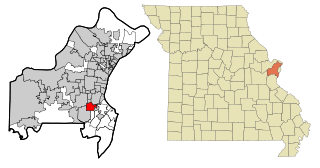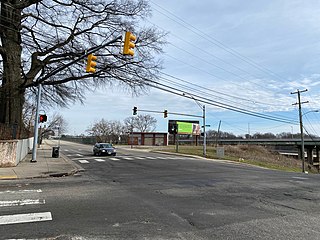
Crestwood is a city in south St. Louis County, Missouri, United States, part of the Metropolitan Statistical Area known as Greater St. Louis. The population was 11,912 at the 2010 census.

Florissant is a city in St. Louis County, Missouri, within Greater St. Louis. It is a middle-class, second-ring northern suburb of St. Louis. Based on the 2020 United States census, the city had a total population of 52,533.

Kirkwood is an inner-ring western suburb of St. Louis located in St. Louis County, Missouri. As of the 2010 census, the city's population was 27,540. Founded in 1853, the city is named after James P. Kirkwood, builder of the Pacific Railroad through that city. It was the first planned suburb located west of the Mississippi River.

Saint Louis Cemetery is the name of three Catholic cemeteries in New Orleans, Louisiana. Most of the graves are above-ground vaults constructed in the 18th and 19th centuries.

Bellefontaine Cemetery is a nonprofit, non-denominational cemetery and arboretum in St. Louis, Missouri. Founded in 1849 as a rural cemetery, Bellefontaine is home to a number of architecturally significant monuments and mausoleums such as the Louis Sullivan-designed Wainwright Tomb, which is listed on the National Register of Historic Places.

George Washington Carver National Monument is a unit of the National Park Service in Newton County, Missouri. The national monument was founded on July 14, 1943, by Franklin Delano Roosevelt, who dedicated $30,000 to the monument. It was the first national monument dedicated to an African American and first to a non-president.

The Mordecai House, built in 1785, is a registered historical landmark and museum in Raleigh, North Carolina that is the centerpiece of Mordecai Historic Park, adjacent to the Historic Oakwood neighborhood. It is the oldest residence in Raleigh on its original foundation. In addition to the house, the Park includes the birthplace and childhood home of President Andrew Johnson, the Ellen Mordecai Garden, the Badger-Iredell Law Office, Allen Kitchen and St. Mark's Chapel, a popular site for weddings. It is located in the Mordecai Place Historic District.

The Old Lorimier Cemetery in Cape Girardeau, Missouri was established between 1806 and 1808 by Louis Lorimier. The cemetery is located at 500 North Fountain Street overlooking the Mississippi River. There are believed to be more than 6,500 graves in the cemetery, most of them unmarked. A sidewalk serves as a north – south dividing line in the cemetery. It is said that Catholics are buried on the south and Protestants are buried on the north. The east slope is believed to be the burial grounds of African-American persons. It has been recorded that as many as 1,200 soldiers from the Civil War were buried there. The grave marker for the wife of Louis Lorimier says "The Noblest Matron of the Shawnee race."

Julius Pitzman (1837–1923) was a Prussian-born American surveyor and city planner best known for his development of the private, gated neighborhoods in St. Louis, Missouri from 1867 through about 1914.
Quinette Cemetery is a historic landmark and African-American burial ground located in Kirkwood, Missouri, a suburb of the city of St. Louis.

Greenwood Cemetery is a historic cemetery established in 1874, and located at 6571 St. Louis Avenue in Hillsdale, Missouri. This was the first non-denominational commercial cemetery for African-Americans in the St. Louis area.

Eden Cemetery is a historic African-American cemetery located in Collingdale, Pennsylvania. It was established June 20, 1902, and is the oldest existing black owned cemetery in the United States. The cemetery covers about 53 acres and contains approximately 93,000 burials.

The Rye African-American Cemetery, also known as the African Cemetery in Rye, is a historic 1.4 acre cemetery on North Street in Rye, New York. It was established as a burying ground for local African-Americans in 1860 through a donation of land by the Underhill family with the intent that it “shall forever hereafter kept, held and used for the purpose of a cemetery or burial place for the colored inhabitants of the said Town of Rye, and its vicinity free and clear of any charge". At least 35 of the individuals buried there are American veterans including men who served with the 20th United States Colored Infantry Regiment. The last documented burial in the cemetery was in 1964.

Stony Hill Cemetery, also known as the Cemetery of the Asbury Colored Peoples Church, is a historic cemetery located at Harrison, Westchester County, New York. It is an example of a rural, 19th century African American burial ground.
Edgar Monsanto Queeny was an American businessman who served as chairman of the Monsanto corporation from 1928 until his retirement in 1960.

Moses Dickson (1824–1901) was an abolitionist, soldier, minister, and founder of the Knights of Liberty, an anti-slavery organization that planned a slave uprising in the United States and helped African-American enslaved people to freedom through the Underground Railroad. He also founded the black self-help organization The International Order of Twelve Knights and Daughters of Tabor and was a co-founder of Lincoln University in Missouri.
Washington Park Cemetery is a historic African-American cemetery active from 1920 until 1980 and located in Berkeley, Missouri, a suburb of St. Louis, Missouri. Large-scale disinterment occurred over several decades for various construction projects. As of 2022, local cleanup efforts continue due to its long-term state of disrepair.

The Shockoe Hill African Burying Ground was established by the city of Richmond, Virginia, for the interment of free people of color, and the enslaved. The heart of this now invisible burying ground is located at 1305 N 5th St.















